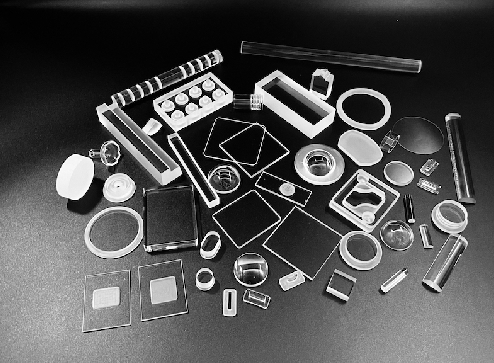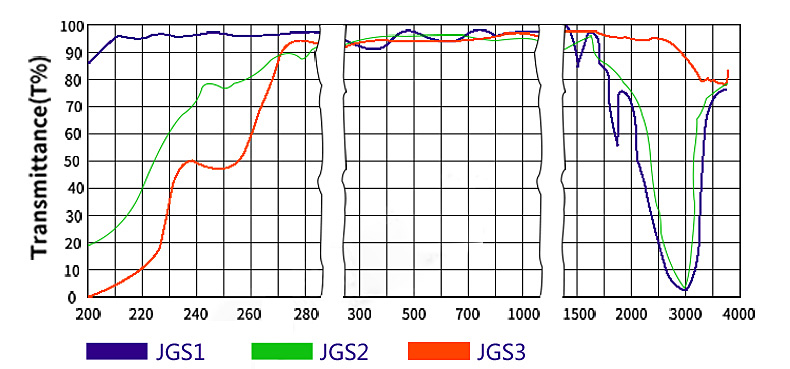

Transparent Quartz Glass: Contains few or no bubbles and scattering particles. It includes fused quartz (SiO₂ content above 99.97%) and synthetic quartz (SiO₂ content above 99.995%). Mainly used in the semiconductor, electric light source, metallurgy, chemical industries, and defense technology.
Opaque Quartz Glass: Contains numerous tiny bubbles and scattering particles, making it opaque or translucent. Typically made from pure silicon sand (SiO₂ content above 99.5%) or high-purity crystal for semiconductor applications. It offers better thermal insulation than transparent quartz glass but slightly inferior overall performance. Due to simpler production processes and abundant raw materials, it is more economical and used in chemical synthesis reactors, acid-resistant pipelines, optical glass melting crucibles, refractory materials, and other electrical and thermal materials.
Optical Quartz Glass:
Based on the spectral transmission range, optical quartz glass is divided into three types: far-ultraviolet (FUV), ultraviolet (UV), and infrared (IR).
UV Optical Quartz Glass
UV optical quartz glass refers to quartz glass with excellent transmittance in the ultraviolet wavelength range. It can be further divided into far-ultraviolet and general ultraviolet types.
Far-Ultraviolet Quartz Glass: Synthetic Quartz Glass,JGS1 quartz glass Characterized by high purity, absence of bubbles, lack of particle structure, and radiation resistance. The application spectral wavelength range is 185-2500 nm.
General Ultraviolet Quartz Glass:Fused Quartz Glass,JGS2 Quartz glass Made from high-quality crystal using the gas refining method. It has slightly lower purity, and the UV absorption edge shifts to longer wavelengths. The application spectral wavelength range is 220-2500 nm. It is primarily used in precision optical instruments, analytical instruments, astronomical instruments, and space technology.
IR Optical Quartz Glass:JGS3 Quartz glass
IR optical quartz glass refers to quartz glass with excellent transmittance in the near-infrared wavelength range. It is used in the spectral wavelength range of 260-3500 nm. Made from high-quality crystal or silicon, it is processed into blanks using the vacuum pressing method and then annealed into various optical components. Due to its low hydroxyl content, it has better infrared transmittance. It is mainly used in infrared detection and tracking systems, precision optical instrument components, industrial furnace observation windows, missile antenna covers, radar delay lines, and color television delay line panels.
Quartz Glass Transmission
Cerium-Doped Quartz Glass
This type of quartz glass is produced by doping cerium ions into the glass. It has excellent absorption properties in the ultraviolet region, with an absorption peak at 320 nm. Under UV excitation, it exhibits fluorescence. Laser xenon lamps made with this glass have 22% higher radiant energy and approximately 16% overall efficiency improvement compared to ordinary xenon lamps. Their lifespan is increased more than tenfold, reaching over 10 million cycles. Cerium-doped quartz glass is used as the tube wall material for laser pumps in small neodymium pentaphosphate lasers, medium and small power Nd lasers, and high-power neodymium glass lasers, improving efficiency and extending lifespan. It is currently used in laser rangefinders, laser nuclear fusion, diamond laser drilling, and other fields.
UV-Filtering Quartz Glass
UV-filtering quartz glass is made by doping praseodymium and other metal ions into the quartz glass. It strongly absorbs ultraviolet light while retaining the excellent properties of quartz glass. Short-wave UV-filtering quartz glass is suitable for making high-pressure mercury lamps, germicidal lamps, and xenon lamps, used in medical, cinema projection, and other everyday lighting applications. It prevents short-wave UV from causing burns to human skin and forming ozone in the air. Long-wave UV-filtering quartz glass is used as a light source for color photo printing plates, improving color printing quality, and as the third-generation light source and filter material for solid-state lasers, enhancing laser efficiency by 20-50%, extending the light source lifespan to over 10 million cycles, eliminating UV radiation damage to humans, and preventing corrosion of devices and environmental pollution by filter liquids. This allows for the miniaturization of lasers.
|
Mechanical Property |
Reference Value |
Mechanical Property |
Reference Value |
|
Density |
2.203g/cm |
Refractive Index |
1.45845 |
|
Compressive Strength |
>1100Mpa |
Coefficient of thermal expansion |
5.5×10/°C |
|
Bending Strength |
67Mpa |
Hot work temperature |
1750~2050°C |
|
Tensile Strength |
48.3Mpa |
The temperature for a short time |
1300°C |
|
Poisson's Ratio |
0.14~0.17 |
The temperature for a long time |
1100°C |
|
Elastic Modulus |
71700Mpa |
Resistivity |
7×107Ω.cm |
|
Shearing Modulus |
31000Mpa |
Dielectric Strength |
250~400Kv/cm |
|
Moths Hardness |
5.3~6.5(Moths Scale) |
Dielectric Constant |
3.7~3.9 |
|
Deformation Point |
1280°C |
Dielectric absorption coefficient |
<4×104 |
|
Specific Heat(20~350°C) |
670J/Kg°C |
Dielectric loss coefficient |
<1×104 |
|
Thermal Conductivity(20°C) |
T1.4W/m°C |
Typical Mechanical Property of Fused Quartz |
|
Avoid contact with alkaline substances at high temperatures to maintain anti-crystallization performance.
ApplicationsQuartz glass can be made into tubes, rods, plates, blocks, and fibers, and shaped into various instruments and vessels. It can be cut, ground, and polished into optical components like mirrors and lenses. With added impurities, it can yield new types with special properties, such as ultra-low expansion or fluorescent quartz glass. Its high-temperature resistance, low expansion coefficient, thermal shock resistance, chemical stability, and electrical insulation make it suitable for use in semiconductors, electric light sources, optical communications, laser technology, optical instruments, laboratory equipment, chemical industry, electrical engineering, metallurgy, and construction materials.
We offer custom processing of products based on customer-specified materials and unique shapes and sizes. Our range of materials includes high-quality options such as:
Schott (Germany):
SCHOTT Borofloat® 33
SCHOTT D 263®
SCHOTT AF45®
SCHOTT AF32®
SCHOTT SUPREMAX® 33
SCHOTT Duran® 8330
ZERODUR, Robax, AF32,Schott S7010N Samarium doped Quartz glass.
Corning (USA): Gorilla Glass (2320, 5318, 7318), Eagle-XG, Pyrex 7740
Other Materials: K9 glass, BK7 glass, B270 glass, sapphire glass
Optical quartz glass (Chinese grades JGS1, JGS2, JGS3), Corning (USA), Heraeus (Germany), and Ohara (Japan),Cerium doped quartz glass.
Our processing capabilities encompass a variety of shapes and finishes, including polishing, drilling, slotting, edge trimming, and grinding. We cater to the needs of scientific research institutions, laboratories, and universities by offering precision machining services with a minimum order quantity of just one piece.
Contact us to experience our high-quality services and explore how we can meet your specific requirements.
Name: Jake Wang
Mobile:+86 16725261381
Tel:
Whatsapp:+8616725261381
Email:sales@lygglass.com
Add:Pingming Town Resident Industrial Park, Donghai County, Lianyungang City, Jiangsu Province